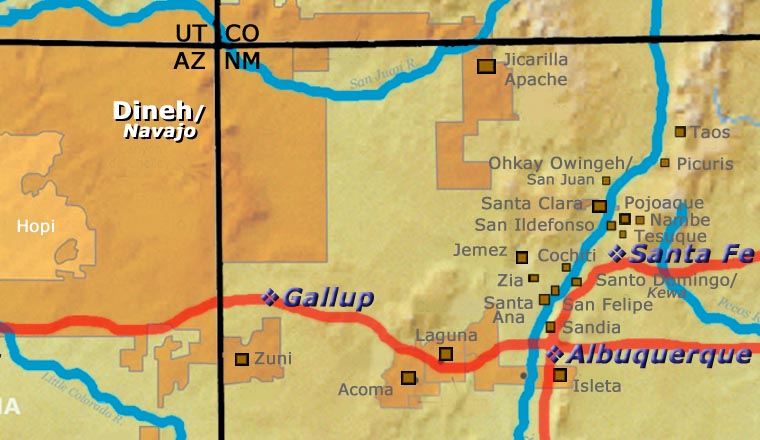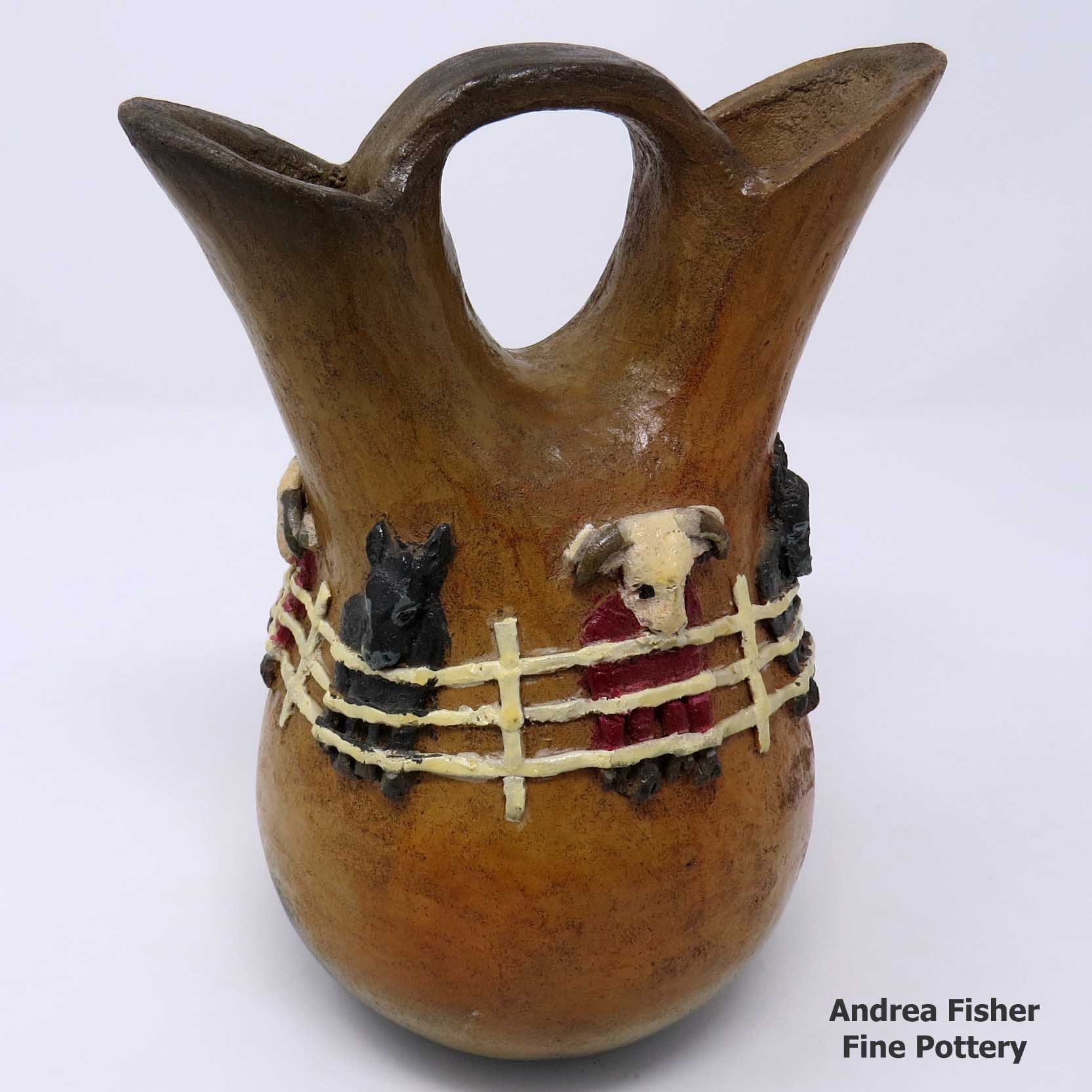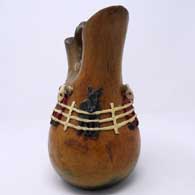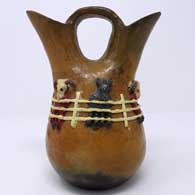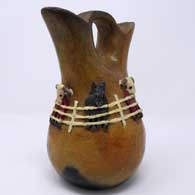
Silas Claw
Dineh (Navajo)
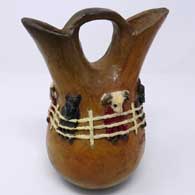
Silas Claw was born into the Dineh Lok'aa'dine'e (the Reed People) clan in December 1913. He grew up near Cow Springs but was sent away to boarding schools for his education. After ten years of formal education, he left Tuba City High School and returned to Cow Springs to help his family with their herds of sheep and cattle. Around 1949 he married Bertha Little of the T'od'ich'i'i'nii (the Bitter Water) clan.
Silas had learned to speak English while he was at the boarding schools but Bertha never went to a formal school and never learned more than a few words of English. The Claws never had any children of their own but they did help raise ten nieces and nephews that belonged to Bertha's brother who lived nearby.
Silas and Bertha raised sheep on a farm they inherited from Bertha's family near Cow Springs. A problem with that was the limitation the Federal government placed on the size of Dineh and Hopi sheep and cattle herds when Glen Canyon Dam was built on the Colorado River. Those limitations imposed a severe hardship on the people and prevented them from being able to support themselves solely on the products they derived from their herds.
Through the years Silas would leave home and seek seasonal employment to supplement their income. Those experiences found him working with the Indian Division of the Civilian Conservation Corps, picking vegetables for Mormon farmers in Utah, working on railroad track repair gangs, and assisting with bona-fide archaeological excavations. During the 1970s, Silas worked on excavations around Black Mesa and other areas of the Navajo Nation. He also acted as an interpreter and field assistant for anthropologist Scott C. Russell.
The early 1970s was when the Hopi Tribe filed a suit in Federal Court that caused major disruptions in the area around Cow Springs and Black Mesa. A large piece of land there was in dispute between the Hopis and the Navajo Nation and a Federal judge ordered the removal of all people living in the area until the case was sorted out. . That forced removal from the land caused most of the Cow Springs-area residents to relocate to HUD housing in Tuba City until the case was finally adjudicated in the mid 1990s.
Silas and Bertha said they learned to make pottery on their own, beginning around 1968. However, the home of Rose Williams was close by and Rose was always happy to answer people's questions and help them learn, as long as they spoke and understood the Dineh language: Rose never went to a formal school and didn't learn to speak English.
While Silas and Bertha each could and did make pots on their own, in collaborations Bertha usually made the vessel body while Silas did the decorating. Their earlier vessels (during the 70s) were traditional and conventional in both form and manufacture. It was in those early years that the Claws made a couple changes in their process. First, they substituted a marine varnish on items made for commercial sale to tourists while they continued to use pine pitch only for fellow Dineh. They didn't use acrylic paint on pitched surfaces either, the pitch made the acrylics run. The marine varnish didn't cause the acrylics to run and they saved a lot of time and energy by not having to gather and prepare the pitch. It was also during this time that they began to add appliqués to their wares. The 1970s saw a lot of experimentation with appliqués of ears of corn, plants, animals and other items placed around the vessel. This new technique was strictly for economic purpose, hopefully making their wares more desirable. Using a thin coat of marine varnish also worked best with these new appliqués because the pitch didn't just smear the paint, it also puddled in nooks and crannies and obscured the details.
The Claws dug their clay from a deposit near their home, albeit a different deposit than that used by most Cow Springs-area potters. For temper they used ground up prehistoric pottery sherds that they found near Tuba City. The sherds were ground up on a metate (flat piece of stone used for grinding corn and grains into flour) and added to their processed clay. Bertha would coil and form the vessels, then wrap them in plastic bags to keep them moist until Silas could make and apply the appliqués. Then they would put the vessels on top of their wood-burning stove until they were dry. At that point they would fire the pieces by putting them inside the burning stove for 30 minutes to an hour. Larger pieces they'd fire in a pit outdoors.
During the mid-1970s to mid-1980s, the appliqués expanded into new forms of decoration. Silas said he first started with acorns and leaves, later adding pine cones, ears of corn, horned toads, yucca and saguaro cactus and animal heads, all in that order. Most of the figurative pottery they made after about 1985 included the use of bright acrylic paint. The appliqués prior to then were all left unpainted, though on occasion Silas would use a translucent tint to highlight features. The acrylic painting was done after firing and either before or after varnishing. They couldn't use acrylic paint on pitched vessels either as the pitch would cause the acrylic to run and smear. It was also during this time that the Claws made some pieces with both etched and painted scenes. Many of Silas' features were shaped in high relief and often in full round.
During the 1980s, their nieces, Ella Shortman and Daisy Tate, began helping them with their pottery. For the most part, Daisy and Ella seem to have done most of the acrylic painting. Around 1985 Silas stopped signing his work. Bertha had never signed any of hers and their collaborations had previously been signed with either "Silas B. Claw" or "S.B. Claw" inscribed in the base. Silas passed on in 2002. Bertha passed on about twenty years later. Some folks think Silas and Bertha may have produced more than 4,000 pieces in their thirty-plus years of making pottery.
100 West San Francisco Street, Santa Fe, New Mexico 87501
(505) 986-1234 - www.andreafisherpottery.com - All Rights Reserved

Dineh
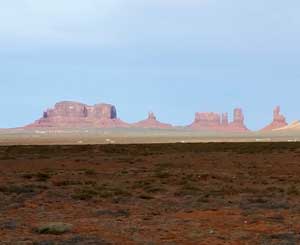
A view in Monument Valley
The Dineh refers to themselves as "Dineh" because the word means "the People" in their language. "Navajo" is a name that was given to them by the early Spanish. Historical and archaeological evidence points to the Dineh people entering the Southwest around 1400 CE. Their oral history still contains stories of that migration as the journey began in eastern Alaska and northwestern Canada centuries after their ancestors made the journey across the Bering Land Bridge from central Asia about 10,000 years ago. They were primarily hunter-gatherers until they came into contact with the Pueblo peoples and learned the basics of survival in this drier climate. Dineh oral history points to a long relationship between the Dineh and the Puebloans as they learned from and traded with each other.
When the Spanish first arrived, the Dineh occupied much of the area between the San Francisco Peaks (in Arizona), Hesperus Mountain and Blanca Peak (in Colorado) and Mount Taylor (in New Mexico). Spanish records indicate they traded bison meat, hides and stone to the Puebloans in exchange for maize and woven cotton goods. It was the Spanish who brought sheep to the New World and the Dineh took to sheep-herding quickly with sheep becoming a form of currency and sign of wealth.
When the Americans arrived in 1846, things began to change. The first fifteen years were marked by broken treaties and increasing raids and animosities on both sides. Finally, Brigadier General James H. Carleton ordered Colonel Kit Carson to round up the Dineh and transport them to Bosque Redondo in eastern New Mexico for internment. Carson succeeded only by engaging in a scorched earth campaign in which his troops swept through Dineh country killing anyone carrying a weapon and destroying any crops, livestock and dwellings they found. Facing starvation and death, the last band of Dineh surrendered at Canyon de Chelly.
Carson's campaign then led straight into "the Long Walk" to Bosque Redondo, a 300-mile trek during which at least 10% of the people died along the way. At Bosque Redondo they discovered the government had not allocated an adequate supply of water, livestock, provisions or firewood to support the 4,000-5,000 people interned there. The Army also did little to protect them from raids by other tribes or by Anglo citizens. The failure was such that the Federal government and the Dineh negotiated a treaty that allowed the people to return to a reservation that was only a shadow of their former territory little more than a couple years after they had left. However, succeeding years have seen additions to the reservation until today it is the largest Native American Reservation in the 48 contiguous states.
Large deposits of uranium were discovered on the Navajo Nation after World War II but the mining that followed ignored basic environmental protection for the workers, waterways and land. The Dineh have made claims of high rates of cancer and lung disease from the environmental contamination but the Federal government has yet to offer comprehensive compensation.
As a semi-nomadic tribe, the Dineh never made much pottery, preferring to use baskets for most storage purposes. They did produce a small amount of pottery for ceremonial uses. Once they were settled on a reservation, pottery began to make more sense. From a beginning making simple wares for colonial estates they transformed their pottery into art. After 1950 Cow Springs brownware began to appear on the market. A trader named Bill Beaver was in Shonto back then, encouraging local potters to "make something different" and the market in the outside world responded positively to those different creations.
Rose Williams is considered the matriarch of modern Dineh pottery. She learned from Grace Barlow (her aunt) and passed her knowledge and experience on to her daughters and many others. Today, most Dineh pottery is heavy, thick-walled and coated with pine pitch (a sealer they also use on many of their baskets). Most Dineh pottery has little in the way of decoration but many pieces have a biyo' (a traditional decorative fillet) around the rim. Unlike Puebloan potters, Dineh potters do not grind up old pot sherds and use them for temper in creating new pottery. Their religion says those pot sherds are infused with the spirits of their ancestors and that forbids the reuse of the material. Similarly, Dineh religion limits Dineh potters to using primarily Dineh carpet designs in the decoration of their pots.
Dineh potters have also created a panoply of folk art, including unfired clay creations called "mud toys." Other Dineh potters, like Christine McHorse, have graduated into the mainstream of American Ceramic Art and easily compete among the finest ceramic artists on Earth.
100 West San Francisco Street, Santa Fe, New Mexico 87501
(505) 986-1234 - www.andreafisherpottery.com - All Rights Reserved

Dineh
$ 450
lynvg7326
Polychrome wedding vase with fire clouds plus cattle and fence design
7.75 in H by 5.5 in Dia
Condition: Very good
Signature: SB Claw
100 West San Francisco Street, Santa Fe, New Mexico 87501
(505) 986-1234 - www.andreafisherpottery.com - All Rights Reserved

The Story of
the Wedding Vase
as told by Teresita Naranjo of Santa Clara Pueblo
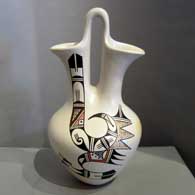
Helen Naha
Hopi
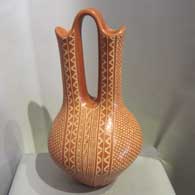
Wilma Baca Tosa
Jemez Pueblo
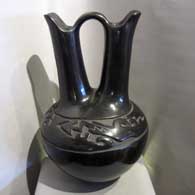
Margaret Tafoya
Santa Clara Pueblo
The Wedding Vase has been used for a long, long time in Indian Wedding Ceremonies.
After a period of courtship, when a boy and girl decide to get married, they cannot do so until certain customs have been observed. The boy must first call all his relatives together to tell them that he desires to be married to a certain girl. If the relatives agree, two or three of the oldest men are chosen to call on the parents of the girl. They pray according to Indian custom and the oldest man will tell the parents of the girl what their purpose is in visiting. The girl's parents never give a definite answer at this time, but just say that they will let the boy's family know their decision later.
About a week later, the girl calls a meeting of her relatives. The family then decides what answer should be given. If the answer is “no” that is the end of it. If the answer is “yes” then the oldest men in her family are delegated to go to the boy's home, and to give the answer, and to tell the boy on what day he can come to receive his bride-to-be. The boy must also notify all of his relatives on what day the girl will receive him, so that they will be able to have gifts for the girl.
Now the boy must find a Godmother and Godfather. The Godmother immediately starts making the wedding vase so that it will be finished by the time the girl is to be received. The Godmother also takes some of the stones which have been designated as holy and dips them into water, to make it holy water. It is with this holy water that the vase is filled on the day of the reception.
The reception day finally comes and the Godmother and Godfather lead the procession of the boy's relatives to the home of the girl. The groom is the last in line and must stand at the door of the bride's home until the gifts his relatives have brought have been opened and received by the bride.
The bride and groom now kneel in the middle of the room with the groom's relatives and the bride's parents praying all around them. The bride then gives her squash blossom necklace to the groom's oldest male relative, while the groom gives his necklace to the bride's oldest male relative. After each man has prayed, the groom's necklace is placed on the bride, and the bride's is likewise placed on the groom.
After the exchange of squash blossom necklaces and prayers, the Godmother places the wedding vase in front of the bride and groom. The bride drinks out of one side of the wedding vase and the groom drinks from the other. Then, the vase is passed to all in the room, with the women all drinking from the bride's side, and the men from the groom's.
After the ritual drinking of the holy water and the prayers, the bride's family feeds all the groom's relatives and a date is set for the church wedding. The wedding vase is now put aside until after the church wedding.
Once the church wedding ceremony has occurred, the wedding vase is filled with any drink the family may wish. Once again, all the family drinks in the traditional manner, with women drinking from one side, and men the other. Having served its ceremonial purpose, the wedding vase is given to the young newlyweds as a good luck piece.
